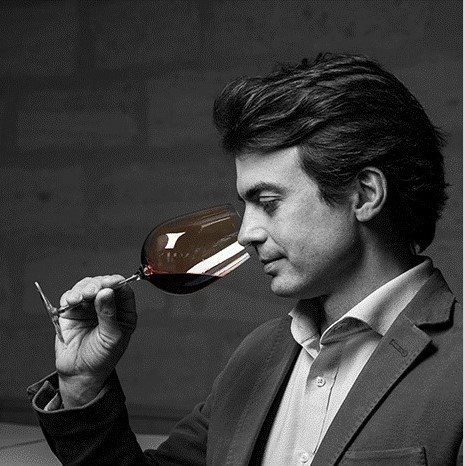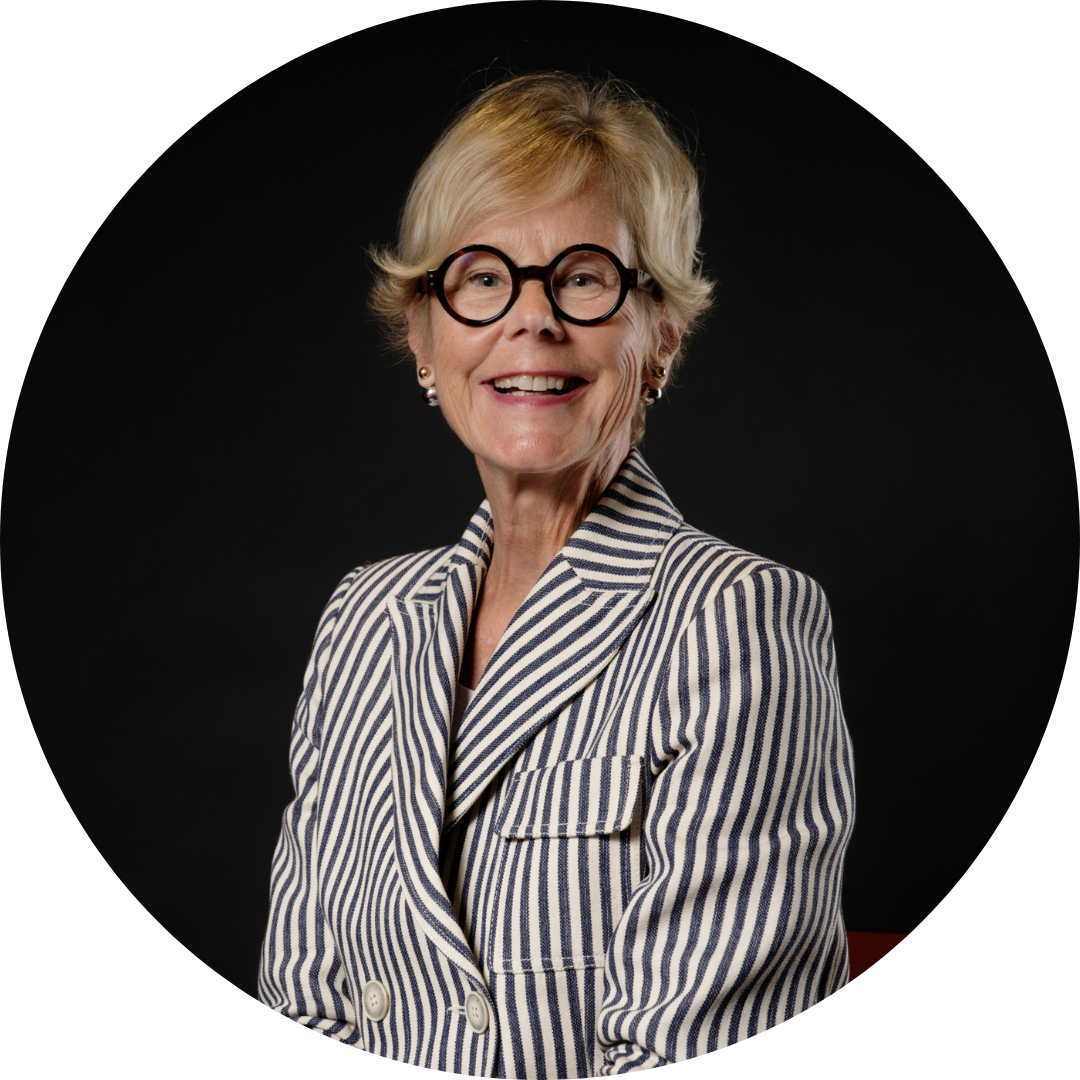Jérôme Poisson
Estates Manager
Château Giscours, Margaux
Caiarossa, Tuscany
~
An agricultural engineer and oenologist, Jérôme Poisson has a rich experience in the world of wine before becoming general manager for AJ Domaines, Château Giscours, and Caiarossa, IGT Toscane. He began his career as an intern at Baron Philippe de Rothschild. In 2006, he harvested at Saintsbury in Napa Valley. Back in France, he completed an internship at Hennessy in Cognac, then returned abroad to work at Clos Apalta at Marnier-Lapostolle. In 2013, Tuscany came calling, and he became assistant to the technical director at Frescobaldi in Montalcino, a position he held until 2016. After a year of consulting, he joined the Pfaffenheim winery in Alsace in 2018, where he was able to share the rich experience he had gained abroad. In January 2021, Jérôme finally settles down at AJ Domaines (Albada-Jelgersma): Château Giscours and Caiarossa.
Presentation
Gerda: What are the main challenges you face in your job?
Jérôme Poisson: It’s certainly the diversity of my tasks. I’m lucky enough to work with Alexander van Beek (Managing Director of AJ Domaines) on various aspects of Château Giscours and Caiarossa. Although my background is technical, my position as estates manager allows me to mobilize all my skills: communication, marketing, agriculture, technical. Giscours is a huge estate, not only in terms of size, but also in terms of diversity. We have a vast park, wilderness areas, vineyards and an events division. One of the challenges of my job is to maintain focus and distance, while remaining close to everyone. It’s the most complex part of my job, but also the most interesting.
G: Is its a question of creating synergy between the different activities at Château Giscours?
JP: All actions must be aligned with the same strategy defined by Alexander. It’s essential for me to be close to the technical side of things, to our farms, our park and the forest, while working closely with the marketing, communications and sales team. My aim is to convey a clear vision, while highlighting and promoting the work done at Giscours. What’s impressive about Giscours is not just the technique applied in the vineyards and the winery, but also the richness of a unique ecosystem and the human values put forward here. These are the same values that need to be promoted at Caiarossa too. Caiarossa is much smaller (bought by the Albada-Jelgersma family in 2004, with 70 hectares, 40 of which are planted). It’s a beautiful, diverse place, with a smaller, young and dynamic team. It’s essential that this team moves in the same direction, in line with AJ Domaines’ values, and that there are enriching exchanges between Italy and France. Giscours can take an interest in the evolution of Bordeaux grape varieties in a warmer climate, while the Caiarossa team can benefit from Bordeaux know-how.
G: You’ve worked in many different wine regions: Cognac, Chile, Italy, Napa Valley, Alsace. What has this diversified career brought you?
JP: It has developed my curiosity. I love discovering new things in different fields and learning new languages. You have to be willing to reach out to others. What also motivates me is to be constantly learning. It’s very important, when you arrive in a new environment, not to arrive with preconceived ideas. You have to be open-minded to understand the world you’re moving into. Throughout all my experiences, I’ve been able to contribute and see the big picture. That’s something I’m very interested in, and what Alexander was also looking for: someone capable of interacting with a variety of people: at ease with our partners at Place de Bordeaux, technicians, journalists and visitors.
G: You have a wide-ranging role, but what has changed since your arrival in 2021?
JP: Giscours didn’t wait for my arrival to aim for quality. Didier Forêt is a modern technician who knows how to harness current ideas to drive forward Giscours, a vast estate of 300 hectares, 160 of which are vineyards. When I arrived, the first thing was to understand everything that had been achieved, then try to go further, as we did with outside advisers on plant cover.
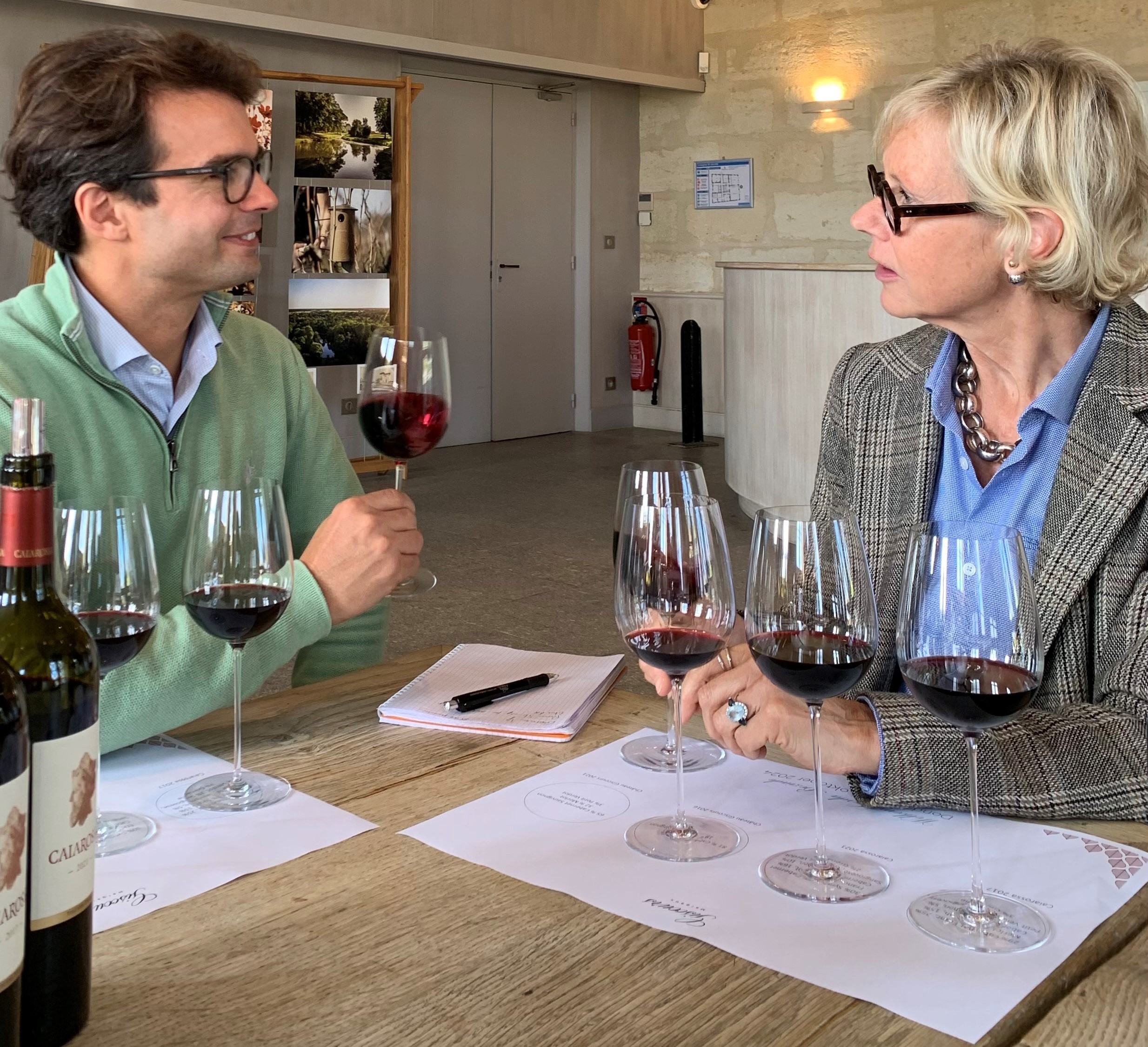
Since then, we’ve enriched our communication with more technical knowledge in exchanges with Alexander and Laure Bastard (Sales Director) as well as Adeline Warthmann (Marketing) integrating all AJ Domaines’ values to make our values clearer and more coherent. Giscours is much more than a brand, and it’s essential to highlight everything it stands for. When I host négociants, I take them on a tour of our vineyards, because it’s important not to stay confined to the tasting room. You have to offer a panoramic view to discover the forest and the whole ecosystem on site, an approach that’s not very common in Bordeaux.
As for Caiarossa, Lorenzo Pasquini (former estates manager of Chateau Giscours, Chateau du Tertre, Caiarossa and now Yquem’s operations manager) has already done an excellent job, but we want to go even further in the precision of the wines, particularly with the arrival of our consultants Valérie Lavigne and Axel Marchal. We also need to think about the coherence of the grape varieties. With Francisco Villa as our on-site technical manager, we have a day-to-day point of reference. It’s essential to make people understand that Caiarossa is an exceptional wine.
Alexander has always put a lot of energy into promoting our wines, and he excels in this area. Laure Bastard is also active in the markets. With so much to say about Giscours and Caiarossa, one more person to get the message across is invaluable, because now, more than ever, it’s crucial to stay close to our customers.
Vine Growing
G: How do you feel about climate change?
JP: What’s happening is becoming more chaotic and extreme. When it’s dry, it’s very dry, and when it rains, it rains a lot. In this context, we need to be resilient, able to absorb shocks and reduce climate excesses. That’s why we decided to increase plant cover. It’s essential to increase the soil’s capacity to absorb water. The gravelly soils of the Médoc are magnificent and produce great wines, because they drain water well. Today, we’re trying to find the right balance: that they continue to drain while retaining water at root level.
G: Yes, because we’ll have other vintages like 2022 in the future.
JP: Exactly. The oceanic climate used to bring a little rain throughout the year. Now, we can have heavy rains in spring, which increases the threat of mildew, followed by a dry, hot summer. Even in our terroirs, a rainy spring does not provide sufficient reserves for the whole year. This year again, the rain at the beginning of September was welcome! So we’re looking for soils that retain water better. Didier and his team have done a lot of work in this direction. We’ve recruited a research and development manager, who is also in charge of the CSR side of things. The aim is to better understand the water capacity of our plants and to be more precise about harvesting. We start by harvesting the young vines in a plot, as they suffer most in dry summers, when they are at their peak in terms of fruit and freshness. It’s a high-precision job.
When it comes to vinification, we’re more minimalist and therefore less interventionist than we used to be. We have to let the grapes express themselves right up to the bottle, which requires great precision in choosing the right moment to harvest. On a large area like ours, this requires meticulous organization. There’s a lot of thought happening here, and Bordeaux has changed a lot in recent years. The region is much greener than it used to be. Contrary to the traditional image that some people sometimes have of us, I think that the people of Bordeaux, far from being stuck in the past, are at the forefront of world viticulture.
G: Are the issues similar in Caiarossa?
JP: In Caiarossa, the phenomenon is even more pronounced. Heat waves are more intense there, and periods of drought can last even longer. This is interesting, because it could give us a glimpse of the future in Bordeaux.
G: Even though Caiarossa’s terroir is on the Mediterranean coast?
JP: We’re lucky to be at altitude. We know that for every 100 meters of altitude, the temperature drops by 1°C on average. So there’s a difference of 3 to 4°C between the vineyards near the coast and those in Caiarossa, which is considerable. What’s more, we benefit from the sea breeze. What we’re doing today in Bordeaux, we’ve been doing for longer in Caiarossa. We’ve started to think about planting density, with a view to reducing it to produce grapes without blockage. These changes will have a long-term impact. In France, appellation decrees limit major changes. At Caiarossa, we have more freedom in terms of grape varieties and growing methods, given that we are in IGT Tuscany.
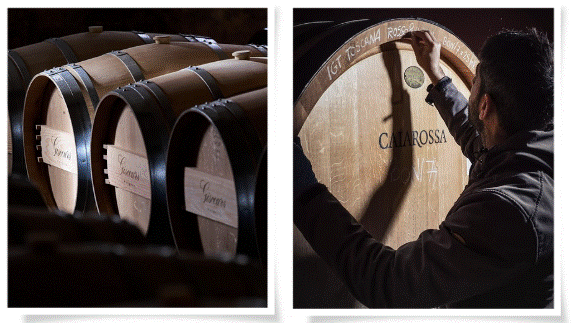
G: Caiarossa practices biodynamic farming; what type of farming do you apply at Giscours?
JP: We focus more on soil conservation or regenerative agriculture. Giscours has also been committed to organic practices without certification for years and is very thoughtful about the use of plant protection products, mainly for the health of our employees and consumers. Today, we view our ecosystem as a whole. This is an aspect of biodynamics that I appreciate, having practiced this method in Chile and Italy at Frescobaldi estates. Some aspects, like the connection with the stars, sometimes go beyond me, but the careful observation and closeness to the plants are very interesting. Biodynamics promotes a vision where the vineyard, wild spaces, animals, and humans form a single living organism that functions in harmony. This is also the spirit at Giscours. We are not just a château surrounded by some vines, but a rich and complex environment in the good sense of the word. Our wild spaces and meadows cover about 240 hectares, more than our vineyards. All our vines are grouped into one block and border the forest. Around twenty families work and live on the property, so there is a real synergy between humans, the natural environment, and agriculture. We are one of the few properties in the Médoc with “prix-faiteurs” (people responsible for their own plots). The winemaking spirit remains!
For the past ten years, we have reintroduced animals onto the property. Animals have always been part of Giscours’ history, except after the war when agriculture became more specialized. For example, the Bordelaise cattle breed was nearly extinct in the 1980s. Thanks to a passionate association, we reintroduced them here at Giscours ten years ago. The presence of animals is not artificial; it integrates with the historic buildings (the Suzanne farm). We also have Landaise sheep and Gascon pigs. This creates an harmonious relationship: the sheep graze in the vineyards, the employees enjoy products from the livestock and garden, and everything is used for the Giscours table. The relationship between humans, animals, and the wild space is strong in biodynamics, but it has been part of Giscours’ history for a long time.
G: Since 2018, Thomas Duclos has been consulting for you at Giscours, and Axel Marchal and Valérie Lavigne have been consulting for Caiarossa since 2017. What do these three consultants bring?
JP: What’s interesting is having an outside perspective. The consultant works with several clients, and their experience elsewhere can give us ideas. They also act as a “sparring partner,” with whom we can exchange ideas and challenge ourselves.
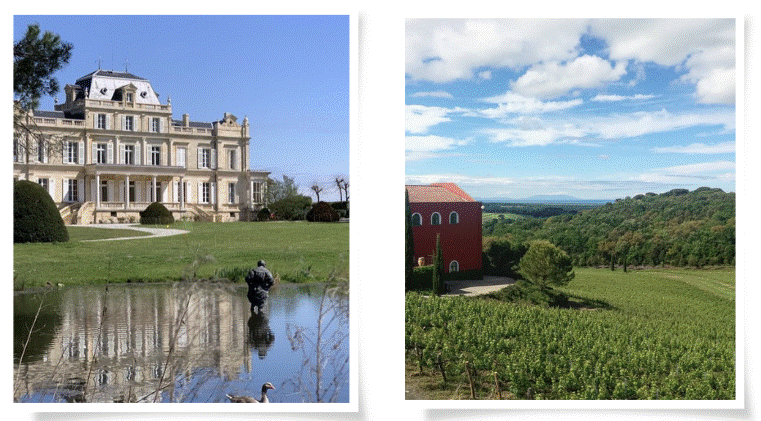
Château Giscours, Margaux Caiarossa, Tuscany
Bordeaux Versus Tuscany
G: Andrew Jefford, a journalist for Decanter, wonders if there are lessons to be learned for Bordeaux from the free-thinking approach in Tuscany. What do you think?
JP: It’s true that the IGT (Indicazione Geografica Tipica) designation offers a lot of technical and stylistic freedom. This was the case for Ornellaia and Sassicaia, which ultimately helped create the Bolgheri DOC (Denominazione di Origine Controllata). The IGT strengthens the brand’s importance over the denomination.
As for Bordeaux, we already have very strong brands and have found a balance between the brand and the denomination. I think consumers already have a clear idea of the style of a Margaux, Saint-Julien, Pauillac, Saint-Émilion, or Saint-Estèphe. I don’t think it would be an advantage if we were to lose that. However, it is true that the appellation can sometimes be a technical straitjacket that forces a uniform style of wine. There are already discussions questioning the appellations, especially in the south of France, where there is a lot of drought. Over there, they are thinking about irrigation, planting density, and how to adapt to climate change.
G: Are we in France too purist in establishing very strict rules for our appellations? For Andrew Jefford, Bordeaux faces challenges partly due to the monolithic nature of its offer.
JP: No, I don’t think so. In Bordeaux, there is not a unique style. We have the brand’ strength and the identity of each estate. There is still a lot to be done in Bordeaux to promote our wines. Often, those who criticize Bordeaux haven’t had Bordeaux wine in a long time. It’s essential to get Bordeaux back into glasses because our wines are not just about oak and tannins; there’s so much more.
G: How can we attract new consumers to Bordeaux? The Gen Z, who has never known a world without the internet and even “zaps” when it comes to wine?
JP: Young people are attached to their values. We can see this with the decline in meat consumption due to its negative impact on the environment and health. It’s important to highlight that wine carries beautiful values: respect for the land, people, and nature. We need to make this generation understand that Bordeaux is neither intimidating nor dusty, and that it is not strict. On the contrary, Bordeaux is firmly modern, and Giscours is a great example of that.
G: What makes your wines stand out and unique?
JP: Not long ago, we did a large vertical tasting, and we could really recognize the Giscours style in every vintage. There is a signature, with a finish dominated by the Cabernets, which are unique: saliva-inducing, licorice-like, and saline. Giscours is a blend of power and elegance. Margaux as a whole is known for its finesse and floral notes. Giscours has all the characteristics of Margaux, but with more structure; it offers a generous mid-palate and a finish full of character.
It is essential to master the power at Giscours to produce a wine that is pleasant to drink young, but that can also age well due to its structure. It’s the perfect balance. Making an overly powerful wine is easy, but not very interesting. A very fine wine can be beautiful, but it doesn’t correspond to the spirit of Giscours. It’s a wine of gastronomy that stimulates the appetite. It’s a great wine for sharing, one that deserves to be appreciated. Giscours is still a wine that people drink, and that’s also its strength.
As for Caiarossa, it’s primarily an exceptional place, where the Tuscan hills meet the sea, immersed in pristine nature. This terroir stands out for its altitude, its ventilation, its complexity, which express themselves in each wine. With a bottle of Caiarossa, you experience the full intensity of Tuscany, its Mediterranean aromas, but also a great freshness and remarkable precision. It’s a fascinating meeting between this exceptional terroir and the art of Bordeaux blending, which reveals its unique identity.
Harvest 2024
G: Could you tell me a few words about the 2024 harvest at Giscours?
JP: This is a vintage marked by climate change. The year started with concerns about frost. Due to milder winters, plants wake up too early. This wasn’t an issue before, but now we worry about it every year. Fortunately, we weren’t affected in 2024. The beginning of the summer, in June and July, was cool and wet, which delayed the development of the vines. This vintage required a lot of work from the technical teams to fight against the sanitary pressures. Cover crops played a crucial role, helping us access the vines and highlighting their importance. We managed to harvest more grapes than in recent years, though the yield will not be high.
Everyone talks about the rain, but August was dry and hot. The veraison was slow, but it went well, and the grapes were able to reach maturity without suffering. The rain in early September was even welcome. We started harvesting on September 20th. The harvest was very reactive due to unstable weather conditions. We mobilized 200 harvesters in the vineyards. Didier did precise work. Fortunately, the nights were cool enough to preserve the health of the grapes. We will see that in the glass, as these great terroirs of the Médoc reveal themselves even in difficult conditions. The varying conditions from one estate to another make it difficult to assess 2024 uniformly. We were lucky to finish the harvest late. We have grapes with no vegetal notes and no sensation of coldness. In 2024, we will experience a more mature sensation in the mid-palate. I think 2024 will be a lovely and unique vintage! Amid the chaos of climate change, diversity emerges. That’s why Bordeaux still has a long future ahead of it.
The Wines
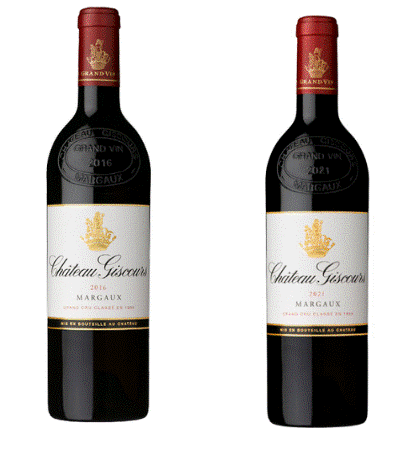
Giscours 2016
JP: 2016 is a very great vintage, during which the weather was perfect. The wines were quite different from 2015, which is also a superb vintage. 2016 was especially more closed in the beginning. Over the past year, it has been opening up more and more. It’s a very Cabernet-driven vintage, with 80% Cabernet Sauvignon. Generally, in great vintages at Giscours, there is always a large proportion of Cabernet. In the vineyard, we have two-thirds Cabernet Sauvignon planted. In the blend, it can vary, but it is the flagship grape, as it is capable of expressing a strong personality. We are fortunate to have very different terroirs, which bring a lot of complexity to the blend and are very complementary. Merlot adds a layer of softness and density.
G: When you replant, do you plant more Cabernet Sauvignon?
JP: Yes, we plant a lot of Cabernet Sauvignon. We have been working on a nursery with mass selections from old vines. Soon, we will have our own plant material for replanting.
Giscours 2021
G: I really like the nose of this vintage, which presents very beautiful, crunchy fruit without vegetal notes.
JP: On the palate, it’s a very fine wine. It doesn’t have the opulence of a hot vintage, but it is refined and elegant, with even a “British” touch.
G: I remember very well Giscours 1983, which is a great vintage from Giscours that has aged remarkably well. Do you focus more on drinkability in its youth today?
JP: Yes, with Thomas Duclos, we work a lot on this point because it wasn’t a strength when the wine was young. Today, we focus more on gentle extractions at the start of fermentation, trying to build the wine without roughness. This fits into the framework of increasingly precise harvests, foot by foot. This allows us to obtain grapes that have their own personality and are always refined in terms of tannins, then we work with them to highlight these qualities in the wine. In this case, the wine expresses itself better when young, with more brilliance. This is important because wine is not only made up of structure and tannins, but also of its expression in youth.

Caiarossa 2017
JP : It’s a complex vintage because it was hot, but especially marked by a great drought. It’s very interesting because we can see that, even in this type of vintage, Caiarossa maintains its fruit and freshness, with fine tannins, which is not easy to achieve. You can really see the quality of the terroir in a difficult vintage. This wine has only 30% new oak, but it has a lot of character, like the Mediterranean scrubland.
G: Yes, exactly. You mentioned the salinity of Giscours, but this wine has it too, and even more so, with a taste of garrigue.
JP: It’s spicy, because the Syrah and Cabernet Franc blend very well together.
Caiarossa 2021
JP : In four years, there has been an evolution; the vines have aged. The average age of the vines is now about 20 years. In the 2021 blend, there is more Syrah and less Merlot. Half of the blend consists of Cabernet Franc and Syrah, and this is becoming the typical blend. The two pair very well together, and we’ve recently planted more Syrah. The work of Axel and Valérie also plays an important role in terms of finesse and elegance. 2021 is a vintage that wasn’t very hot, but quite dry. It was mainly the drought that was the dominant factor during this vintage, which makes it very different from Bordeaux.
G: It has a lot of elegance.
JP: Yes, but it’s less explosive. It has less of that wild character. The tannins are very fine, and it has a beautiful length.
G: Yes, but it has a perfect balance and is more slender in its structure, with an impressive finish.
JP: Yes, and it will open up more in a few years, but at the tannic level, you can feel the work that has gone into this wine.
Gerda BEZIADE a une incroyable passion pour le vin, et possède une parfaite connaissance de Bordeaux acquise au sein de prestigieux négoces depuis 25 ans. Gerda rejoint Roland Coiffe & Associés afin de vous apporter avec “Inside La PLACE“ davantage d’informations sur les propriétés que nous commercialisons.

